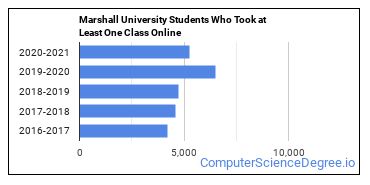Marshall University Computer Science Programs
Located in Huntington, West Virginia, Marshall University is a public institution. The city atmosphere of Huntington makes it a great place for students who enjoy having lots of educational and entertainment options.
Featured schools near , edit
Where Is Marshall University?

Contact details for Marshall University are given below.
| Contact Details | |
|---|---|
| Address: | 1 John Marshall Dr, Huntington, WV 25755 |
| Phone: | 304-696-3170 |
| Website: | www.marshall.edu |
How Do I Get Into Marshall University?
You can apply to Marshall University online at: https://www.marshall.edu/admissions/apply/
Admission Requirements for Marshall University
| Submission | Required? |
|---|---|
| High School GPA | 1 |
| High School Rank | 3 |
| High School Transcript | 1 |
| College Prep Program | 3 |
| Recommendations | 3 |
| SAT or ACT Scores | 5 |
| TOEFL | 1 |
How Hard Is It To Get Into Marshall University?
Approximately 41% of accepted students are men and 59% are women. The acceptance rate for men is 96%, and the acceptance rate for women is 97%.
Can I Afford Marshall University?
The net price is calculated by adding tuition, room, board and other costs and subtracting financial aid.
Student Loan Debt
Almost 66% of college students who graduated with the class of 2018 took out student loans, but that percentage varies from school to school. At Marshall University, approximately 47% of students took out student loans averaging $5,854 a year. That adds up to $23,416 over four years for those students.
Marshall University Undergraduate Student Diversity

There are also 3,015 graduate students at the school.
Gender Diversity
Of the 6,553 full-time undergraduates at Marshall University, 42% are male and 58% are female.

Racial-Ethnic Diversity
The racial-ethnic breakdown of Marshall University students is as follows.

| Race/Ethnicity | Number of Grads |
|---|---|
| Asian | 86 |
| Black or African American | 384 |
| Hispanic or Latino | 155 |
| White | 5,520 |
| International Students | 85 |
| Other Races/Ethnicities | 323 |
Geographic Diversity
West Virginia students aren't the only ones who study at Marshall University. At this time, 33 states are represented by the student population at the school.
Over 70 countries are represented at Marshall University. The most popular countries sending students to the school are China, India, and Saudi Arabia.
Online Learning at Marshall University
The following chart shows how the online learning population at Marshall University has changed over the last few years.

Marshall University Computer Science Concentrations
The table below shows the number of awards for each concentration.
| Major | Bachelor’s | Master’s | TOTAL |
|---|---|---|---|
| General Computer & Information Sciences | 15 | 4 | 19 |
| Computer & IS Security | 14 | 5 | 19 |
| Information Technology Management | 0 | 3 | 3 |
| Other Computer & Information Sciences & Support Services, Other | 3 | 0 | 3 |
| General Information Science | 0 | 1 | 1 |
| TOTAL | 32 | 13 | 45 |
References
*The racial-ethnic minorities count is calculated by taking the total number of students and subtracting white students, international students, and students whose race/ethnicity was unknown. This number is then divided by the total number of students at the school to obtain the racial-ethnic minorities percentage.
- College Factual
- National Center for Education Statistics
- Image Credit: By Beyond My Ken under License
More about our data sources and methodologies.
Featured Schools
 Request Info
Request Info
|
Southern New Hampshire University You have goals. Southern New Hampshire University can help you get there. Whether you need a bachelor's degree to get into a career or want a master's degree to move up in your current career, SNHU has an online program for you. Find your degree from over 200 online programs. Learn More > |
